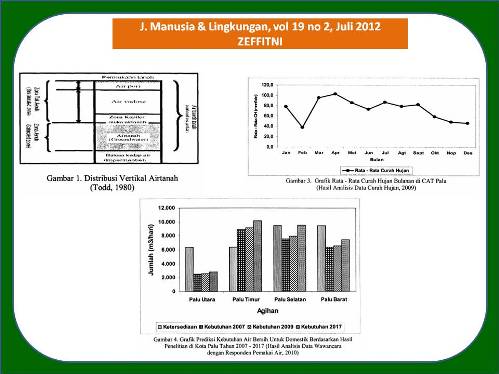
AGIHAN SPASIAL EKOLOGIKAL POTENSI AIRTANAH UNTUK KEBUTUHAN DOMESTIK DI CEKUNGAN AIRTANAH PALU PROVINSI SULAWESI TENGAH (Spatial Ecological Distribution of Groundwater Potency to Domestic Availability at Palu Groundwater Basin Central Sulawesi Province)
Zeffitni Zeffitni(1*)
(1) Jurusan Teknik Sipil Universitas Tadulako, Palu
(*) Corresponding Author
Abstract
ABSTRAK
Peningkatan jumlah penduduk dan pengembangan berbagai sektor seperti domestik, industri, jasa, pertan ian dan sektor lainnya di Kota Palu, secara langsung maupun ,tidak langsung menuntut penyediaan sumber air bersih yang semakin meningkat. Penelitian ini bertujuan untuk: menganalisis potensi kuantitatif airtanah bebas dan tertekan berdasarkan agihan spasial ekologikal dan menyusun pola arahan spasial pemanfaatan airtanah untuk kebutuhan domestik. Pendekatan utama dalam penelitian ini adalah analisis spasial ekologikal dengan metode survei sebagai dasar untuk analisis potensi kuantitatif air tanah. Hasil penelitian menunjukkan bahwa : 1) tingkat potensi kuantitatif air tanah bebas rata-rata sedang (1,0-5,0 liter/detik), mata air kecil (<5,0 liter/detik) dan besar (>10,0 liter/detik), dan air tanah tertekan besar rata-rata > 10,0 liter/detik namun di beberapa tempat bernilai nihil (tidak ada data pengukuran), 2) kebutuhan air bersih di daerah perkotaan (Kecamatan Palu Timur) pada tahun 2017 diperkirakan akan lebih tinggi daripada di daerah pedesaan (Kecamatan Palu selatan dna Palu Barat) dan 3) agihan zona penurapan air tanah terdiri atas : zona penurapan I: potensi air tanah sedang – tinggi di Kecamatan Palu Timur dan Palu Barat (pusat kota), zona penurapan II: potensi air tanah sedang di Kecamatan Palu Selatan (daerah transisi) dan zona penurapan III: potensi air tanah sangat terbatas, agihan di daerah yang tidak termasuk daerah arahan penurapan, yaitu Kecamatan Palu Utara, Kabupaten Donggala dan Sigi (daerah pinggiran) karena meupakan daerah imbuhan air tanah (recharge area)
ABSTRACT
The increasing of population number and development of various sectors such as domestic, industrial, services, agriculture and other sectors at Palu City directly or indirectly also require increasing provision of fresh water sources. This study aimed to: analyze the groundwater potency based on distribution of spasial ecological and to compose the design of spatial direction groundwater for domestic used. he study of spatial distribution of groundwater potency based on the approach of spatial ecological to be done with survey methods. The research result indicate that: 1). level of quantitative potency for unconfined groundwater medium category, amount 1.0- 5,0 litre/second, spring debit small (<5.0 litre/seconds) and big (>10.0 litre/seconds), and confined groundwater are big (> 10.0 litre/ seconds), 2). groundwater demand at city area (East Palu District) at 2017 predicted high from rural area (South Paluand West Palu District), and 3). the landing groundwater: plastering zone I: groundwater high – medium potential, distribution in west and east Palu District (Central City), plastering zone II: groundwater potential exactly, distribution in South Palu (Transsition Region), and plastering zone III: groundwater very limit, distribution in region not plastering: North Palu District, Donggala and Sigi Regency (Edge Region).
Keywords
Full Text:
ARTIKEL LENGKAP (PDF) (Bahasa Indonesia)Article Metrics
Refbacks
- There are currently no refbacks.
Copyright (c) 2017 Jurnal Manusia dan Lingkungan







